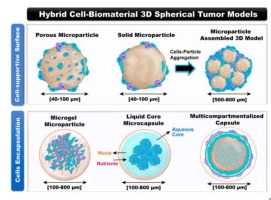Acta Biomaterialia ( IF 9.4 ) Pub Date : 2018-05-23 , DOI: 10.1016/j.actbio.2018.05.034 L.P. Ferreira , V.M. Gaspar , J.F. Mano

|
Three-dimensional multicellular tumor models are receiving an ever-growing focus as preclinical drug-screening platforms due to their potential to recapitulate major physiological features of human tumors in vitro. In line with this momentum, the technologies for assembly of 3D microtumors are rapidly evolving towards a comprehensive inclusion of tumor microenvironment elements. Customized spherically structured platforms, including microparticles and microcapsules, provide a robust and scalable technology to imprint unique biomolecular tumor microenvironment hallmarks into 3D in vitro models. Herein, a comprehensive overview of novel advances on the integration of tumor-ECM components and biomechanical cues into 3D in vitro models assembled in spherical shaped platforms is provided. Future improvements regarding spatiotemporal/mechanical adaptability, and degradability, during microtumors in vitro 3D culture are also critically discussed considering the realistic potential of these platforms to mimic the dynamic tumor microenvironment. From a global perspective, the production of 3D multicellular spheroids with tumor ECM components included in spherical models will unlock their potential to be used in high-throughput screening of therapeutic compounds. It is envisioned, in a near future, that a combination of spherically structured 3D microtumor models with other advanced microfluidic technologies will properly recapitulate the flow dynamics of human tumors in vitro.
Statement of Significance
The ability to correctly mimic the complexity of the tumor microenvironment in vitro is a key aspect for the development of evermore realistic in vitro models for drug-screening and fundamental cancer biology studies. In this regard, conventional spheroid-based 3D tumor models, combined with spherically structured biomaterials, opens the opportunity to precisely recapitulate complex cell-extracellular matrix interactions and tumor compartmentalization. This review provides an in-depth focus on current developments regarding spherically structured scaffolds engineered into in vitro 3D tumor models, and discusses future advances toward all-encompassing platforms that may provide an improved in vitro/in vivo correlation in a foreseeable future.
中文翻译:

球形结构3D体外肿瘤模型的设计-进展与展望
三维多细胞肿瘤模型作为临床前药物筛选平台正受到越来越多的关注,因为它们具有在体外概括人类肿瘤主要生理特征的潜力。伴随着这种势头,用于组装3D微型肿瘤的技术正在迅速向全面纳入肿瘤微环境元素发展。定制的球形结构平台(包括微粒和微胶囊)提供了强大且可扩展的技术,可将独特的生物分子肿瘤微环境标记印入3D体外模型中。在此,对将肿瘤ECM组件和生物力学线索整合到体外3D中的新进展进行了全面概述提供了在球形平台上组装的模型。考虑到这些平台模仿动态肿瘤微环境的现实潜力,还对在体外3D培养的微肿瘤期间有关时空/机械适应性和降解性的未来改进进行了严格讨论。从全球的角度来看,具有球形模型中包含的肿瘤ECM成分的3D多细胞球体的生产将释放其潜力,可用于治疗化合物的高通量筛选。可以预见的是,在不久的将来,球形结构的3D微型肿瘤模型与其他先进的微流体技术的结合将适当地概括体外人类肿瘤的流动动力学。
重要声明
正确模拟体外肿瘤微环境的复杂性的能力是开发用于药物筛选和基础癌症生物学研究的更加现实的体外模型的关键方面。在这方面,传统的基于球体的3D肿瘤模型与球形结构的生物材料相结合,为精确概括复杂的细胞-细胞外基质相互作用和肿瘤区室化提供了机会。这篇综述深入探讨了工程化到体外3D肿瘤模型中的球形结构支架的最新发展,并讨论了向可能提供改进的体内/体外功能的全平台的未来进展 在可预见的未来的相关性。











































 京公网安备 11010802027423号
京公网安备 11010802027423号